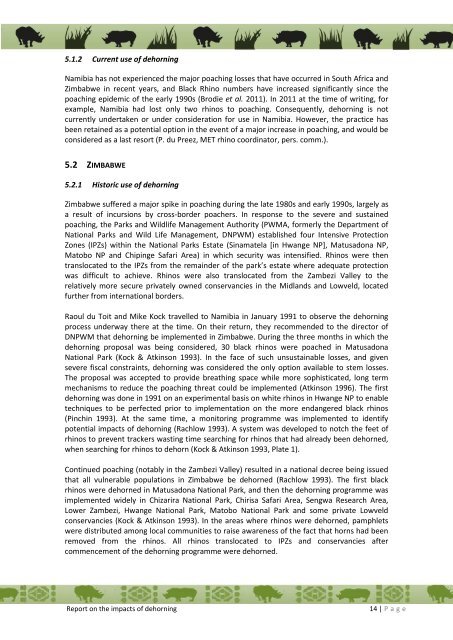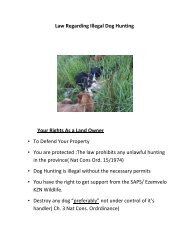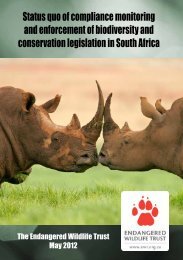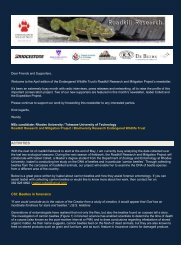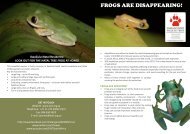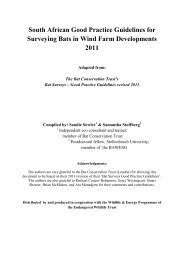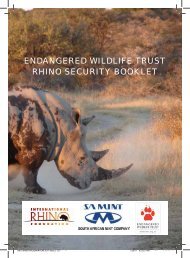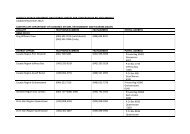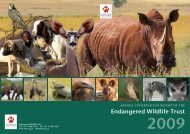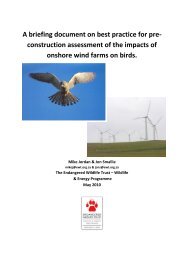click - Endangered Wildlife Trust
click - Endangered Wildlife Trust
click - Endangered Wildlife Trust
Create successful ePaper yourself
Turn your PDF publications into a flip-book with our unique Google optimized e-Paper software.
5.1.2 Current use of dehorningNamibia has not experienced the major poaching losses that have occurred in South Africa andZimbabwe in recent years, and Black Rhino numbers have increased significantly since thepoaching epidemic of the early 1990s (Brodie et al. 2011). In 2011 at the time of writing, forexample, Namibia had lost only two rhinos to poaching. Consequently, dehorning is notcurrently undertaken or under consideration for use in Namibia. However, the practice hasbeen retained as a potential option in the event of a major increase in poaching, and would beconsidered as a last resort (P. du Preez, MET rhino coordinator, pers. comm.).5.2 ZIMBABWE5.2.1 Historic use of dehorningZimbabwe suffered a major spike in poaching during the late 1980s and early 1990s, largely asa result of incursions by cross-border poachers. In response to the severe and sustainedpoaching, the Parks and <strong>Wildlife</strong> Management Authority (PWMA, formerly the Department ofNational Parks and Wild Life Management, DNPWM) established four Intensive ProtectionZones (IPZs) within the National Parks Estate (Sinamatela [in Hwange NP], Matusadona NP,Matobo NP and Chipinge Safari Area) in which security was intensified. Rhinos were thentranslocated to the IPZs from the remainder of the park’s estate where adequate protectionwas difficult to achieve. Rhinos were also translocated from the Zambezi Valley to therelatively more secure privately owned conservancies in the Midlands and Lowveld, locatedfurther from international borders.Raoul du Toit and Mike Kock travelled to Namibia in January 1991 to observe the dehorningprocess underway there at the time. On their return, they recommended to the director ofDNPWM that dehorning be implemented in Zimbabwe. During the three months in which thedehorning proposal was being considered, 30 black rhinos were poached in MatusadonaNational Park (Kock & Atkinson 1993). In the face of such unsustainable losses, and givensevere fiscal constraints, dehorning was considered the only option available to stem losses.The proposal was accepted to provide breathing space while more sophisticated, long termmechanisms to reduce the poaching threat could be implemented (Atkinson 1996). The firstdehorning was done in 1991 on an experimental basis on white rhinos in Hwange NP to enabletechniques to be perfected prior to implementation on the more endangered black rhinos(Pinchin 1993). At the same time, a monitoring programme was implemented to identifypotential impacts of dehorning (Rachlow 1993). A system was developed to notch the feet ofrhinos to prevent trackers wasting time searching for rhinos that had already been dehorned,when searching for rhinos to dehorn (Kock & Atkinson 1993, Plate 1).Continued poaching (notably in the Zambezi Valley) resulted in a national decree being issuedthat all vulnerable populations in Zimbabwe be dehorned (Rachlow 1993). The first blackrhinos were dehorned in Matusadona National Park, and then the dehorning programme wasimplemented widely in Chizarira National Park, Chirisa Safari Area, Sengwa Research Area,Lower Zambezi, Hwange National Park, Matobo National Park and some private Lowveldconservancies (Kock & Atkinson 1993). In the areas where rhinos were dehorned, pamphletswere distributed among local communities to raise awareness of the fact that horns had beenremoved from the rhinos. All rhinos translocated to IPZs and conservancies aftercommencement of the dehorning programme were dehorned.Report on the impacts of dehorning14 | P a g e


